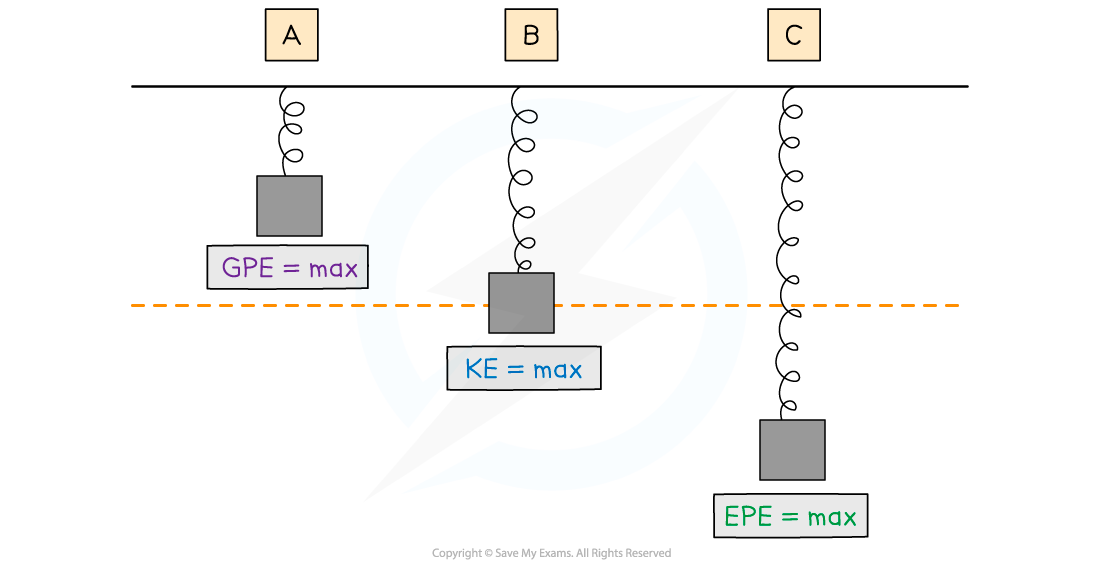Principle of Conservation of Energy (DP IB Physics): Revision Note
Principle of Conservation of Energy
The principle of conservation of energy states that:
Energy cannot be created or destroyed; it can only be transferred from one form to another
This means the total amount of energy in a closed system remains constant, although how much of each form there is may change
In physics, a system is defined as:
An object or group of objects
Defining the system in physics is a way of narrowing the parameters to focus only on what is relevant to the situation being observed
When a system is in equilibrium, nothing changes, and so nothing happens
When there is a change in a system, things happen, and when things happen, energy is transferred
Types of Energy

Kinetic energy, gravitational potential energy, and elastic potential energy are collectively known as mechanical energy types
Energy Dissipation
No energy transfer is 100% efficient
When energy is transformed from one form to another, some of the energy is dissipated to the surroundings
Dissipated energy usually ends up as thermal energy transferred to the surroundings, where it cannot be easily used for another purpose
Therefore, dissipated energy is usually regarded as wasted energy
A kettle transforms electrical energy into thermal energy
The thermal energy in the heating element is transferred to thermal energy in the water
Some thermal energy is also transferred to the plastic casing
Some thermal energy is also dissipated to the surrounding air
The energy transfers that are useful for heating the water are considered useful energy transfers
The energy transfers that are not useful for heating the water are considered wasted energy transfers
Applications of Energy Conservation
In mechanical systems, the energy transferred is equivalent to the work done
A falling object (in a vacuum, where no energy is dissipated into the surroundings) transfers its gravitational potential energy into kinetic energy
Horizontal mass on a spring transfers its elastic potential energy into kinetic energy
A battery or cell transfers its chemical energy into electrical energy
A car transfers chemical energy from the fuel into kinetic energy of the car
A person bouncing on a trampoline is transferring energy from elastic potential to kinetic to gravitational potential

Energy transfers whilst jumping on a trampoline
There may also be work done against resistive forces such as friction
For example, if an object travels up a rough inclined surface, then
Loss in kinetic energy = Gain in gravitational potential energy + Work done against friction
Spring Energy Conservation
When a vertical spring oscillates, its energy is converted into other forms
Although the total energy of the spring will remain constant, it will have changing amounts of:
elastic potential energy (EPE)
kinetic energy (KE)
gravitational potential energy (GPE)

At position A:
the spring has some EPE because it is slightly compressed
KE is zero because it is stationary
GPE is at a maximum because the mass is at its highest point
At position B:
the spring has some EPE because it is slightly stretched
KE is at a maximum as it passes through the equilibrium position at its maximum speed
the spring has some GPE because the mass is still raised
At position C:
EPE is at a maximum because the spring is at its maximum extension
KE is zero because it is stationary
GPE is at a minimum because the mass is at its lowest point
For a horizontal mass on a spring system, you do not need to consider the gravitational potential energy because this does not change
Worked Example
The diagram shows a rollercoaster going down a track.
The rollercoaster takes the path A → B → C → D.

Which statement is true about the energy changes that occur for the rollercoaster down this track?
A. KE - GPE - GPE - KE
B. KE - GPE - KE - GPE
C. GPE - KE - KE - GPE
D. GPE - KE - GPE - KE
Answer: D
At point A:
The rollercoaster is raised above the ground, therefore it has GPE
As it travels down the track, GPE is converted to KE and the roller coaster speeds up
At point B:
KE is converted to GPE as the rollercoaster rises up the loop
At point C:
This GPE is converted back into KE as the rollercoaster travels back down the loop
At point D:
The flat terrain means the rollercoaster only has KE

Unlock more, it's free!
Did this page help you?